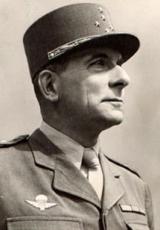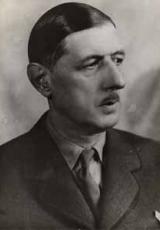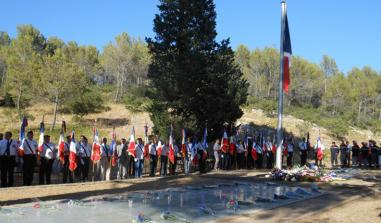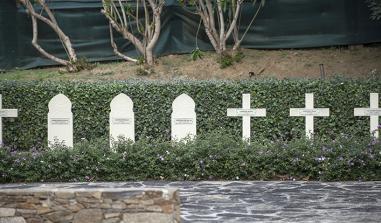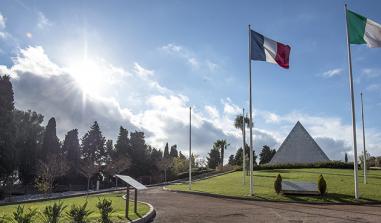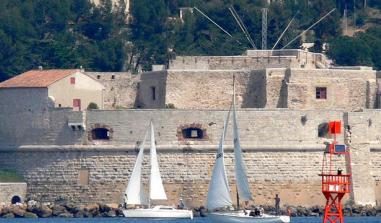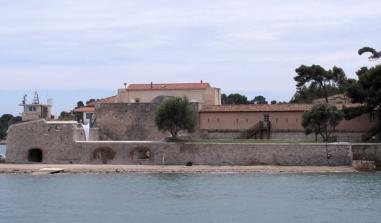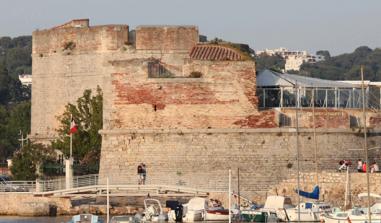Boulouris National Cemetery
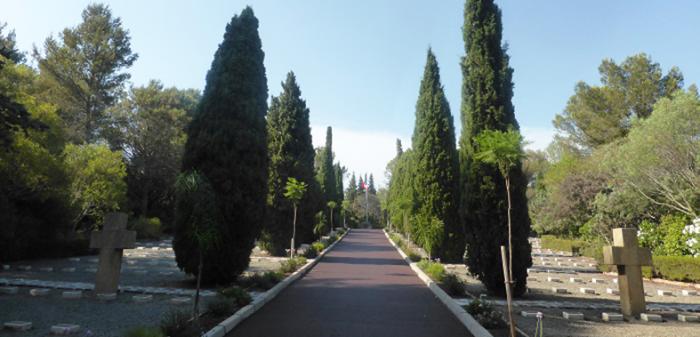
Boulouris National Cemetery, Saint Raphaël. © Guillaume Pichard
Click here to view the cemetery’s information panel 
Located in the commune of Saint Raphaël, Boulouris National Cemetery contains the bodies of 464 French soldiers killed in the fighting of August 1944. These soldiers, of wide-ranging origins and faiths, belonged to Army B, commanded by General de Lattre de Tassigny, which saw action in Provence.
In March 1960, veterans minister Raymond Triboulet accepted the donation by Saint Raphaël town council of a piece of land in Boulouris, at the entrance to the forest of Estérel, for the creation of a cemetery in memory of the Provence landings of 15 August 1944. The cemetery was laid out in 1962-63. In March 1964, operations got underway to relocate the bodies exhumed from the municipal cemeteries of the Var (Draguignan, Toulon, Hyères, Cogolin, Saint-Tropez, etc.) The cemetery was officially opened on 15 August 1964 by President Charles de Gaulle, with a large number of French and African veterans in attendance, gathered to commemorate the 20th anniversary of the Provence landings.
Operation Anvil/Dragoon
Two months after the Normandy Landings of 6 June 1944, the Allies landed in Provence.
Despite significant strategic disagreement among the Allies, the principle of a second invasion in the south of France to complement Operation Overlord was agreed upon as early as November 1943. Churchill wanted the focus to be on northern Italy and the Balkans. Stalin was opposed to this, his preference being for the invasion of Provence, which would relieve the Eastern Front. For Charles de Gaulle, this operation would hasten the liberation of France. In the end, President Roosevelt opted in favour of an operation in the south of France.
The wild and rocky Provençal coastline, with its small beaches, was ill suited to a large-scale invasion. But the relatively deep water near the shore meant the ships would be able to come in close, and the proximity of Corsica would enable the massive use of air power. Above all, the liberation of Provence would bring into play the deep-sea ports of Marseille and Toulon, vital for supplying the Allied armies in France.
The 250 000-strong German 19th Army, under General Wiese, defended the South of France. The German troops had abandoned the hinterland and the secondary routes to concentrate on the main supply routes, like the Rhône Valley, and the coast. The navy and air force were very poorly resourced, and the coastal defences were far less impressive than those of the Atlantic Wall, although the ports of Toulon and Marseille, transformed into entrenched camps, were solidly defended. The two ports would not be captured until after the landings, which did not affect them directly, taking place as they did over 50 miles of coastline between Lavandou and Agay.
15 August 1944: the Allies land in Provence
Command of the assault troops was entrusted to American general Alexander Patch, who had won the Battle of Guadalcanal in the Pacific. He commanded the Seventh United States Army, comprised of General Truscott’s VI Corps and General de Lattre de Tassigny’s Army B (future 1st Army). The French naval presence was much greater than in Normandy, with the destroyer Lorraine and ten cruisers, including the Montcalm and Georges Leygues. The French Forces of the Interior (FFI), highly organised in the South of France and in particular in the Alpine massifs, were tasked with facilitating the landings by harassing the German troops in the hinterland.
Comprised of 800 warships and 1 370 other vessels, the Allied fleet set sail from Corsica, Italy and North Africa carrying 500 000 men. It had air support from 1 500 aircraft. On the night of 14 to 15 August, more than 5 000 Allied paratroopers were dropped behind the Maures massif, in the Muy area, while commandos stormed the enemy batteries along the coast. At dawn, a terrible aerial and naval bombardment fell on the coast and, at 8 am, the first American assault waves landed on the beaches of Alpha, Delta and Camel, between Cavalaire and Saint Raphaël. Despite fierce resistance from the enemy in the Saint Raphaël sector, the landing was a total success, and by the evening of 15 August, a bridgehead roughly 50 miles by 20 had been established.
The liberation of Toulon and Marseille
On 17 August, the German 19th Army received the order for general retreat, with the exception of the Toulon and Marseille garrisons. Capitalising on their initial successes, the Americans headed straight for the Rhône Valley and Route Napoleon, leaving to the French the difficult mission of taking the entrenched camps of Toulon and Marseille.
The Battle of Toulon went on from 18 to 28 August. The 1st Free French Division (1st DFL) took Hyères, then advanced along the coast. The 9th Colonial Infantry Division (9th DIC) manoeuvred through the mountains, while the 3rd Algerian Infantry Division (3rd DIA) took Toulon from behind and continued its advance on Marseille. The French troops approached Toulon, with air and naval artillery support. Fierce fighting to take the city’s forts ensued. For General de Lattre, the fighting brought to mind the battles of Douaumont and Thiaumont, in which he had fought in 1916. Entrenched in the Cap Cépet battery on the Saint Mandrier peninsula, the last German soldiers surrendered on 28 August. During the fighting for Toulon, the troops of the 3rd DIA advanced on Marseille. Guided by the Resistance fighters who had started the uprising, the French soldiers pushed through to the heart of the city. After violent street battles, they whittled down the pockets of resistance, liberating the city on 28 August.
Heading up the Rhone Valley and Route Napoleon, the Allies progressed northwards at lightning speed, liberating Grenoble on 22 August, then Lyon on 3 September. On 12 September, at Montbard (Côte d’Or), French troops of the 2nd DB coming down from Normandy met those coming up from Provence.
Boulouris National Cemetery, Saint Raphaël. © Guillaume Pichard
Nécropole nationale de Saint-Raphaël-Boulouris. © Guillaume Pichard
Nécropole nationale de Saint-Raphaël-Boulouris. © Guillaume Pichard
Boulouris National Cemetery, Saint Raphaël. © Guillaume Pichard
Boulouris National Cemetery, Saint Raphaël. © Guillaume Pichard
Boulouris National Cemetery, Saint Raphaël. © Guillaume Pichard
Boulouris National Cemetery, Saint Raphaël. © Guillaume Pichard
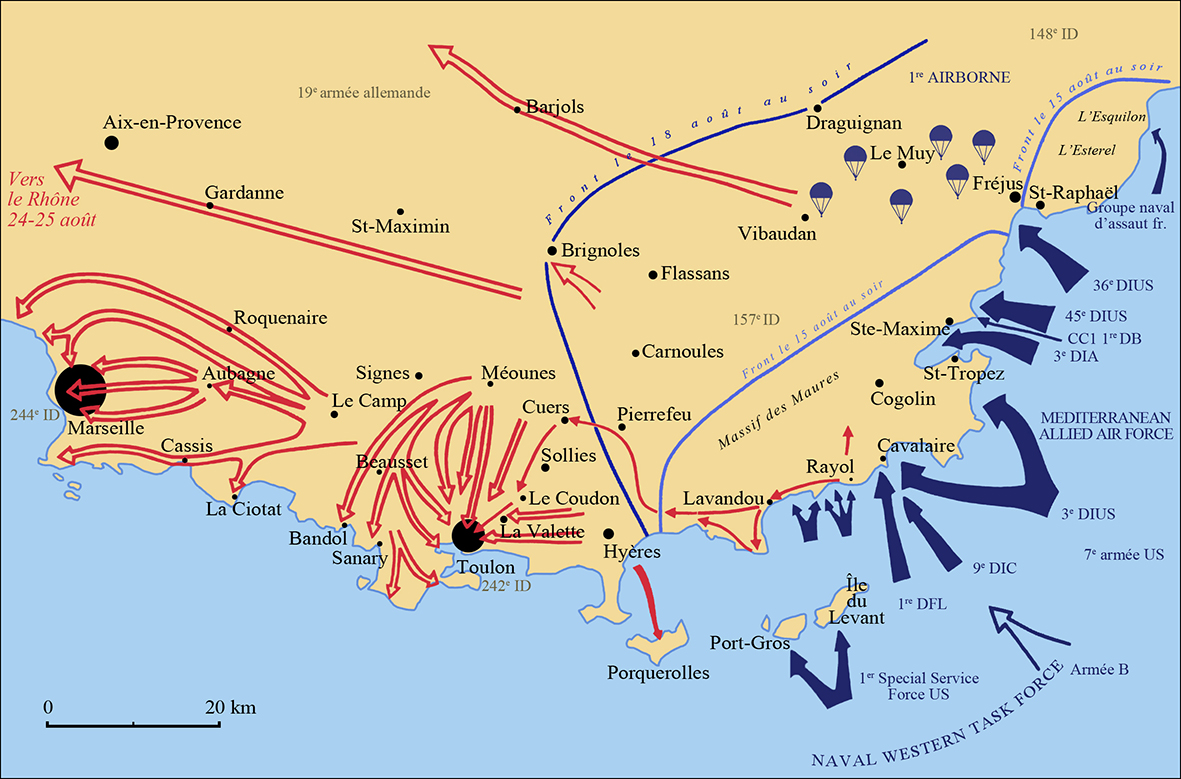
Débarquement et bataille de Provence. © MINARM/SGA/DPMA/Joëlle Rosello
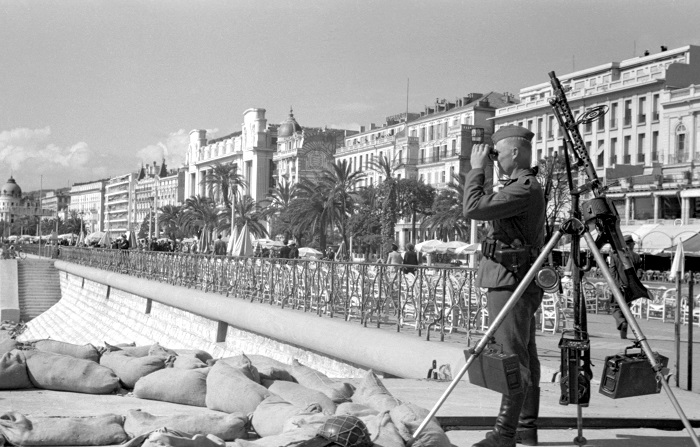
On the Promenade des Anglais in Nice, a German sentry scans the horizon, August 1944. The German coastal defences in Provence were less impressive than those of the Atlantic Wall, but they remained formidable in the two large ports of Toulon and Marseille, which had been turned into entrenched camps. © ECPAD
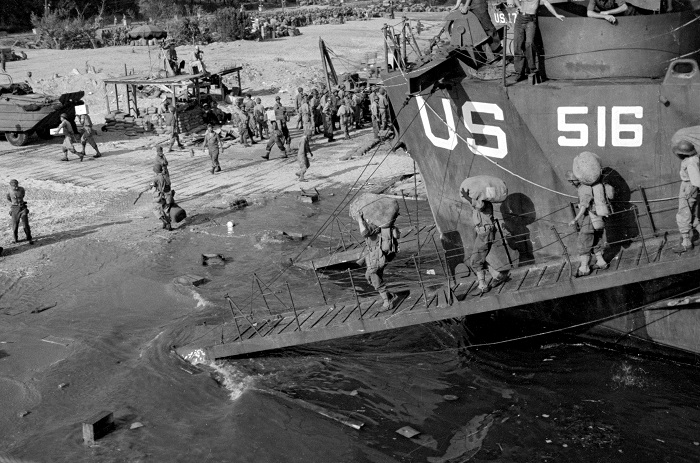
French troops of Army B land in St Tropez, 16 August 1944. The majority of assault troops who landed on 15 August 1944 were American. The first elements of French Army B arrived in Provence the following day. © ECPAD
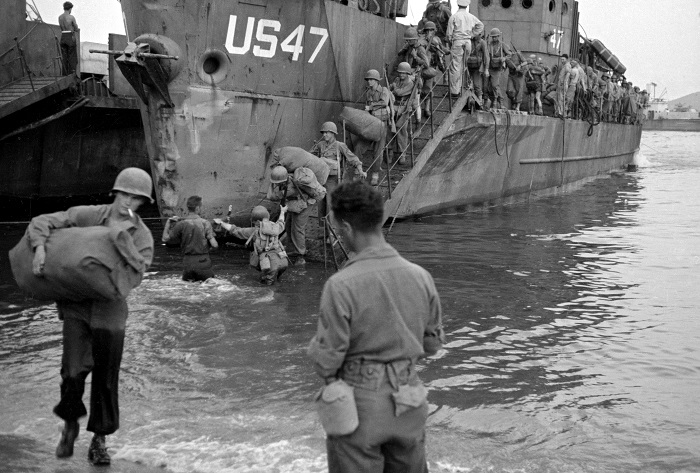
The 3rd Algerian Infantry Division lands in St Tropez, 16 August 1944. Created in May 1943 in Algeria, the 3rd Algerian Infantry Division (3rd DIA) was one of the key units of the French Expeditionary Corps in Italy in 1943-44 (capture of Belvedere, Battle of Garigliano and capture of Siena). Commanded by General de Monsabert, then General Guillaume, the 3rd DIA landed in Provence on 16 August 1944, fought in the Battle of Toulon, liberated Marseille, then took part in the Vosges and Alsace campaign, before entering Germany and taking Stuttgart on 22 April 1945. © ECPAD
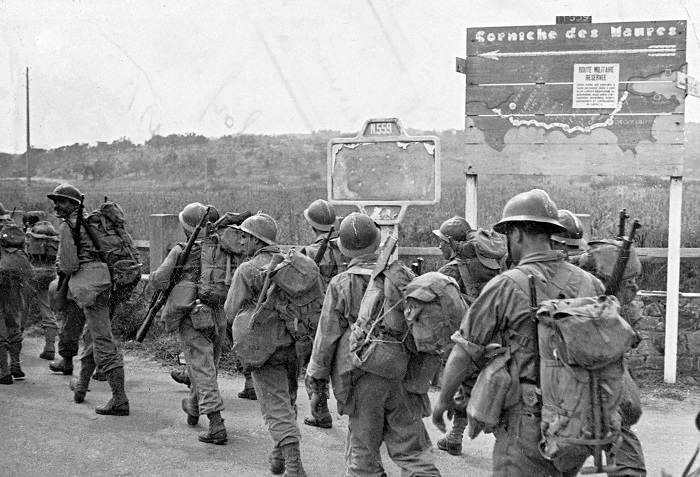
After landing, French troops take up their positions, August 1944. © ECPAD
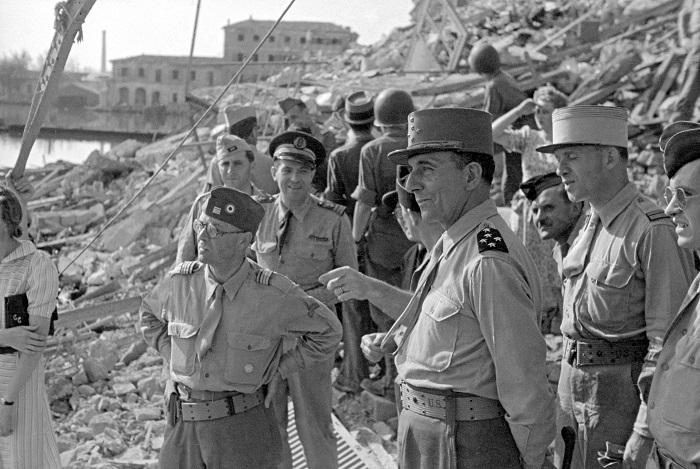
General de Lattre de Tassigny among the ruins of Toulon naval dockyard, August 1944. A veteran of the Great War, arrested by the Vichy authorities in 1942, General de Lattre de Tassigny broke out of Riom prison (Puy-de-Dôme) in 1943 and escaped to North Africa. He landed in Provence at the head of Army B, the future 1st Army, which he commanded throughout the French and German campaigns. He represented France at the signing of the German surrender in Berlin on 8 May 1945. © ECPAD
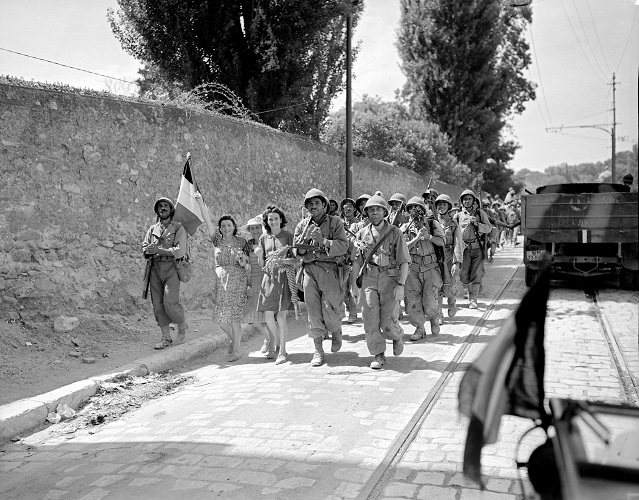
Cheered on by the local population, French riflemen march towards Gardannes, south of Aix-en-Provence, August 1944. © ECPAD
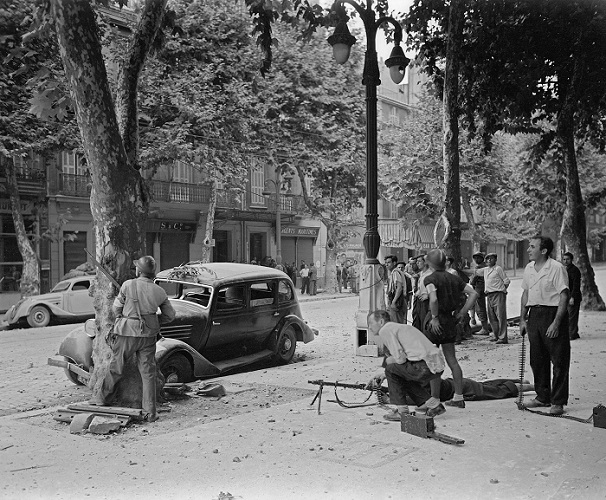
Members of the French Forces of the Interior (FFI) in the streets of Marseille during the fighting of August 1944. On 18 August 1944, the Marseille Resistance organised a strike, followed by a general uprising on 21 August. The arrival of the 3rd DIA was followed by several days of violent street fighting leading up to the German surrender on 28 August. © ECPAD
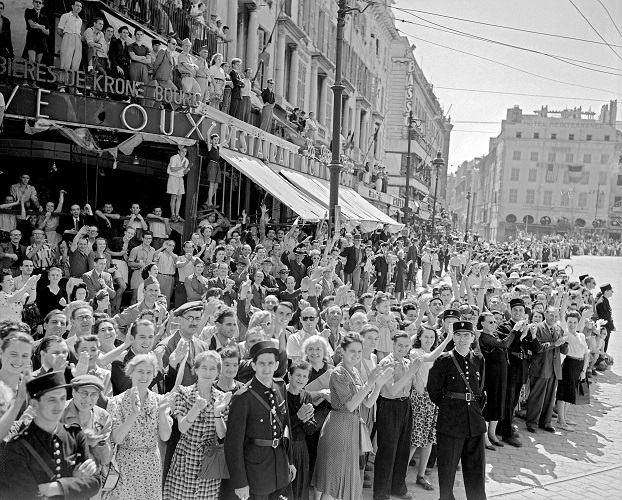
Crowds gathered in Marseille to cheer the liberators – soldiers and FFI fighters – as they paraded through the city on 29 August 1944. © ECPAD
Practical information
Boulouris
Visites libres toute l’année
Summary
East of Saint Raphaël. N 98


